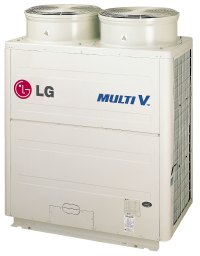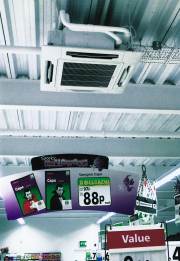VRF air conditioning adds value
There has been a sea change in the energy efficiency and capabilities of VRF air conditioning sytems within the last three years — opening up expanding markets.If you could borrow Doctor Who’s Tardis and go back just a very short time to the year 2002, you would find no inverter-driven air-conditioning products. That piece of information comes from Donald Daw of Mitsubishi Electric. By the end of last year about half of air-conditioning products had inverter drives.
Value for money ‘While products incorporating variable-speed drives are more expensive,’ argues Donald Daw, ‘they represent better value for money.’ The use of inverter drives in VRF air-conditioning system has taken hold very strongly. They are already dominant in this sector, and their use is increasing in split systems. The difference between VRF and split systems is becoming blurred, believes Donald Daw, who believes that a small VRF system is just a high-quality multi-split. There are particularly marked developments in the VRF market, with strong growth in both large and small systems and the application of heat recovery. Donald Daw also tells us that inverter split systems are eroding mid-size heat-pump sales. But it is in heat recovery where VRF is exhibiting its true potential, with over 90% of systems, according to Donald Daw, being heat pump or heat recovery and also providing space heating — rather than there being a separate heating system. This trend is driven by there being no heat requirement in a modern office building if the external temperature is above 5°C. ‘Heat pumps using R410A are very good at heating,’asserts Donald Daw, who doubts that there is a gas-fired boiler with a similarly low level of carbon-dioxide emissions. Compared with condensing boilers the break point for heat-pumps systems to deliver similar carbon-dioxide emissions is a coefficient of performance of 2.8 to 3 — which much equipment easily achieves.
Full benefit To achieve the full benefit of such high-efficiency products, correct selection, application and installation are all important. ‘Today’s equipment has half the energy consumption of equipment that was available just three years ago — if it is used properly,’ asserts Donald Daw. Full-load COPs have increased by 70 to 80%, and part-load COPs have more than doubled. Contributing to the uptake of more sophisticated, and thus more energy-efficient, air-conditioning systems is the UK’s relatively well educated building-services industry and relatively well educated customers compared with other countries. Representative of the high COPs being achieved by VRF equipment is Fujitsu’s recently launched J-Series, which uses a high-performance DC inverter scroll compressor with variable capacity responding to the load during heating and cooling. A COP of 3.2 is achieved in cooling mode and 3.4 in heating mode. The compressor can deliver heat with an outdoor temperature as low as –15°C. R410A is the refrigerant. Nominal cooling capacity is 15.2 kW, with 16.6 kW of heating on the heat-pump versions. Fujitsu’s latest launch is the V-Series, also designed around R410A and using inverter technology. Nominal system capacity is up to 120 kW, serving up to 48 indoor units with a maximum connected capacity of 150%. Specifiers can choose from 28 models across eight types of indoor unit for the J-Series and 55 for the V-Series. They include the popular ceiling cassette, wall-mounted units and duct types.
Migrating features Demonstrating how features first offered with larger systems are migrating to smaller ones is the Multi Free-Joint System from LG Electronics. It provides smaller sites with the benefits of comfort and flexibility in system design and, with the imminent launch of the inverter type, energy savings normally confined to larger installations.

Aimed at larger installations — LG’s Multi V ranges with cooling up to 115 kW.
Using six outdoor units and 30 indoor units, up to 1250 combinations can be achieved. Up to six indoor units of any mix can be connected to an outdoor unit. The selection is from Art Cool, wall mounted, cassette, ducted and convertible. The Multi Free-Joint System features TPS inverter, which uses one high-efficiency constant-speed compressor and the DC inverter for energy savings. This is capable of up to 70% energy savings. LG’s Multi V range of VRF products is aimed at larger installations. Available in sizes from 13 to 115 kW, a single Multi V outdoor unit can serve up to 16 and 64 outdoor units, It can be controlled via the Internet, a PC, a deluxe or simple controller. General manager Tony Gittings says, ‘This is our first move into this part of the air-conditioning market. We are planning further launches with products that will strive to be the industry’s benchmark standard in the sector.’
Low power requirement VRF systems find themselves installed in all kinds of applications, as evidenced by the installation of Toshiba SMMS system providing both heating and cooling for a substantial extension to the Kingswood ASDA Superstore at Hull.

The high EER of 17 ceiling-suspended Toshiba SMMS cassette units of 7.1 kW each in this ASDA store mean that only a 16 A 3-phase ring main is required.
This R410A system required only a 16 A 3-phase ring main, which is a 50% reduction in electricity supply over previous systems. The refrigerant charge is 45% less than in R407C systems. Even at full load the energy-efficiency ratio (EER) is 3.8, and higher at the much more frequent part-load operation. Four outdoor units are sited in a service area in the loading-bay car park, serving 17 ceiling cassettes of 7.1 kW each suspended in an exposed-services installation above the five aisles of the extended store. The installation also takes advantage of Toshiba’s remote monitoring and Interactive Intelligence control system.
Gas powered For projects where there might be an inadequate supply of electricity or because the designer wants a different solution, Sanyo offers a heat-pump VRF system with the compressor driven by a gas-powered internal-combustion engine. Available in Europe as a 3-pipe version, the ECO G GHP requires only a single-phase power supply across the entire range. Other features include simultaneous heating and cooling and 100% heating performance at –20°C. There is a choice of DX or chilled water for indoor heat exchange. Pipe runs can be up to 780 m, and the system requires the engine to be services every 10 000 h (equivalent to one maintenance very 3.2 years, based on 3120 running hours a year). ECO G is part of Sanyo’s VRF family and uses the same controls and indoor units as the rest of the range, so that a system can be mixed and matched with electric VRF units and splits on site. Waste heat from the engine can also be recovered and re-used efficiently. The system is included on the Energy Technology, so it qualifies for Enhanced Capital Allowances. VRF air conditioning is widely applied to guest rooms in hotels. One example using Daikin equipment is the Tulip Inn at North Harbour, Portsmouth. It has over a hundred bedrooms over five floors, as well as lounge areas, restaurant and bars, three meeting rooms and a spacious reception. All areas are served by VRVII heat-recovery air condition installed by Sayes & Co. of Pudsey in Yorkshire. Bedrooms have fan-coil units providing both heating and cooling located in bulkheads above the entry doors. All public areas have Daikin 4-way-blow ceiling cassette units. The 10 outdoor units are in two ground-level compounds at either end of the building. Heat recovery is achieved by diverting exhaust heat from indoor units in cooling mode to areas requiring heating. The control system balances heating and cooling loads, enabling compressors to run at power levels 40 to 45% lower than the norm.
Water cooled While VRF systems have traditionally had air-cooled condensers, two companies now offer water-cooled systems that open up the prospect of VRF being applied to much larger projects — especially in tall buildings. Those companies are Daikin and Mitsubishi Electric. The latter already has projects up and running. Water-cooled systems have space-saving benefits, which have been put to good use in the Zetter Hotel in London. By rejecting heat into water drawn from an underground lake, roof space has been freed up for use as penthouse suites to increase revenue opportunities. The system is based on Mitsubishi’s WR2 equipment. Room card keys enable the air conditioning to come on when a room is occupied and automatically switch it off when the room is vacated. Water-cooled VRF systems offer intriguing scope for engineers to improve energy efficiency by linking up with ground-source heat or using cooling towers for heat rejection. The use of cooling towers raises health-and-safety issues, which specialist companies are well equipped to address, as Bob Macleod-Smith of BAC Balticare explains in the article link below.
Related links:
Related articles:









